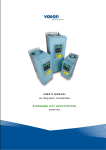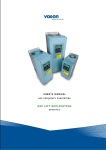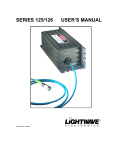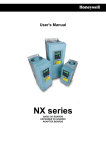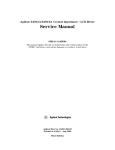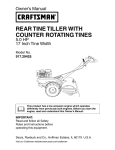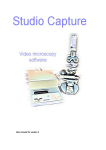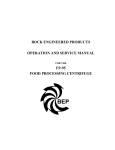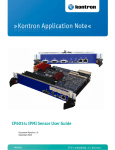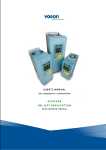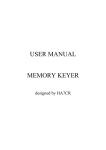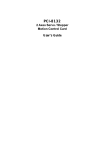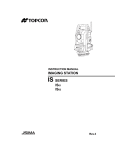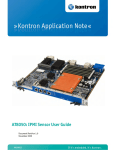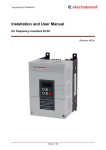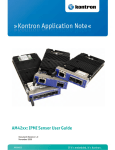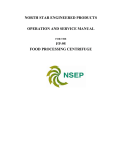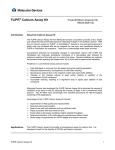Download Vacon Manual NXP APSPFF29
Transcript
VACON LIFT USER’S MANUAL APSPFF29V144 (APSPFF29_RV9_EN_BM) Page 2 Vacon Lift Application (Software APSPFF29) INDEX INTRODUCTION ................................................................................................................3 PROGRAMMING PRINCIPLE OF THE INPUT SIGNALS IN THE LIFT APPLICATION ........................4 CONTROL I/O ..................................................................................................................4 LIFT APPLICATION – PARAMETER LISTS .............................................................................6 4.1 Monitoring values (Control keypad: menu M1) ..................................................... 6 4.2 Basic parameters (Control keypad: Menu M2 Æ G2.1) ........................................ 7 4.3 Speed Control Parameters (Control keypad: Menu M2 Æ G2.2) ......................... 8 4.4 Mechanical Brake control parameters (Control keypad: Menu M2 Æ G2.3) ........ 9 4.5 Drive control parameters (Control keypad: Menu M2 Æ G2.4) ............................ 9 4.6 Motor control parameters (Control keypad: Menu M2 Æ G2.5).......................... 10 4.7 Input signals (Control keypad: Menu M2 Æ G2.6).............................................. 10 4.8 Output signals (Control keypad: Menu M2 Æ G2.7) ........................................... 11 4.9 Protections (Control keypad: Menu M2 Æ G2.8) ................................................ 12 4.10 Autorestart parameters (Control keypad: Menu M2 Æ G2.9) ........................... 13 4.11 Evacuation parameters (Control keypad: Menu M2 Æ G2.10) ……………….. 14 4.12 Closed loop parameters (Control keypad: Menu M2 Æ G2.11)........................ 14 4.13 Open loop parameters (Control keypad: Menu M2 Æ G2.12) .......................... 14 4.14 Permanent Magnet Synchronous Motors (Ctrl.K Menu M2 Æ G2.13)............. 15 4.15 AutoCurve Compensation (Control keypad: Menu M2 Æ G2.14) ..................... 15 4.16 Keypad control (Control keypad: Menu M3)...................................................... 17 4.17 System menu (Control keypad: M6) .................................................................. 17 4.18 Expander boards (Control keypad: Menu M7) .................................................. 17 4.19 Easy Start Up (Control keypad: Menu M8)........................................................ 17 4.20 Photo Monitor (Control keypad: Menu M9) ....................................................... 17 5- DESCRIPTION OF PARAMETERS .......................................................................................19 5.1 BASIC PARAMETERS ...................................................................................... 19 5.2 SPEED CONTROL ............................................................................................ 20 5.3 MECHANICAL BRAKE CONTROL ................................................................... 24 5.4 DRIVE CONTROL ............................................................................................. 32 5.5 MOTOR CONTROL........................................................................................... 33 5.6 INPUT SIGNALS ............................................................................................... 36 5.7 OUTPUT SIGNALS ........................................................................................... 36 5.8 PROTECTIONS ................................................................................................. 37 5.9 AUTO RESTART PARAMETERS ..................................................................... 40 5.10 EVACUATION PARAMETERS ......................................................................... 42 5.11 CLOSED LOOP PARAMETERS ....................................................................... 43 5.12 OPEN LOOP PARAMETERS............................................................................ 45 5.13 PERMANENT MAGNET SYNCHRONOUS MOTORS ..................................... 46 5.14 AUTOCURVE COMPENSATION...................................................................... 47 5.15 KEYPAD CONTROL PARAMETERS................................................................ 48 6. CONTROL SIGNAL LOGIC IN LIFT APPLICATION ....................................................................49 7. FAULT TRACING .............................................................................................................50 1. 2. 3. 4. Vacon Drives Ibérica S.A. Teléfono: +34 93 877 45 06 Fax: +34 93 877 00 09 E-mail: [email protected] Page 3 Lift Application 1. Introduction Lifts Application is specially designed to achieve the best performances on Permanent Magnet Motors, along the start, travel and stop, talking about confort and noises. Moreover this application could control induction motors too. In the application, constant speeds are presented in [m/s] and also in [Hz], acceleration and deceleration are presented in [m/s2] and jerks are presented in [s]. All outputs are freely programmable. Digital input functions are freely programmable to any digital input. Start forward and reverse signals are fixed to input DIN1 and DIN2 (see next page). If more number of inputssignals are needed, we can installed optional boards to extend (NXOPTB1). With Auto Curve Compesation function, the application can be used in high speed lift systems. The converter knows all the time where the lift is, thanks to the encoder information, and which is the next floor to landing. This function enable to have floors with differents heights, and ensure the correct deceleration process to stop in the distance available, improving the cicle time having always the same time in levelling speed the lift. The feature can be used in close loop installations. The hardware will be always the Vacon NXP converter. If you we want to control an induction motor in Close Loop, will need Encoder Boards NXOPTA4 or NXOPTA5. If motor to control is Permanent Magnets, then wil be necessary to use NXOPTBB if the Encoder used is an EnDat (Heidenhein ECN 413 or 1313), or NXOPTAK if the Encoder is Sin/Cos. Page 4 2. Control I/O NXOPTA1 1 2 READY mA Terminal +10Vref AI1+ Signal Reference output Analogue input, voltage range 0—10V DC Description Voltage for potentiometer, etc. Voltage input frequency reference 3 4 5 AI1AI2+ AI2- I/O Ground Analogue input, current range 0—20mA Ground for reference and controls Current input frequency reference 6 7 8 +24V GND DIN1 Voltage for switches, etc. max 0.1 A Ground for reference and controls Contact closed = start forward 9 DIN2 10 DIN3 11 CMA Control voltage output I/O ground Start forward (programmable) Start reverse (programmable) Emergency Stop FEdg (programmable) Common for DIN 1—DIN 3 12 13 14 +24V GND DIN4 15 DIN5 16 DIN6 Free programable 17 18 19 20 CMB AO1+ AO1DO1 Common for DIN4—DIN6 Output frequency Analogue output Digital output RUN Control voltage output I/O ground Speed reference selection (FULL SPEED) Speed reference selection (INSPECTION SPEED) Contact closed = start reverse Contact open = no action Contact closed = stop by coasting Connect to GND or +24V Voltage for switches (see #6) Ground for reference and controls Programmable speed reference for Inputs DIN4, DIN5, and DIN6: Activity reference Activity reference with direction Binary Reference Connect to GND or +24V Programmable Range 0—20 mA/RL, max. 500Ω Programmable Open collector, I≤50mA, U≤48 VDC NXOPTA2 RUN 220 VAC 21 22 23 RO1 RO1 RO1 Relay output 1 RUN Programmable 24 25 26 RO2 RO2 RO2 Relay output 2 MECHANICAL BRAKE Programmable Table 1. Standard application default I/O configuration. Note: See jumper selections below. More information in Vacon NX User's Manual, Chapter 6.2.2.2. Jumper block X 3 : CM A a nd CM B grounding CMB connected to GN D CMA connected to GN D CMB isolated from GN D CMA isolated from GN D CMB and CMA internally connected together, isolated from GN D = Factory default Vacon Drives Ibérica S.A. Teléfono: +34 93 877 45 06 Fax: +34 93 877 00 09 E-mail: [email protected] Page 5 3. EASY START UP (M8) The application has a special Menu for Easy Start Up (M8) In this Menu there are the basic parameters needs in a normal commisioning. Depending on this parameters tuning, the menú will show us the parameters related with this motor control or motor. In the following box we can see the parameters list that we can find depending on the control which we want to make: P8.1 – Motor Model P8.2 – Motor Nominal Voltage P8.3 – Motor Nominal Frequency P8.4 – Motor Nominal Speed P8.5 – Motor Nominal Current P8.6 – Motor Cos phi P8.7 – Motor Type P8.8 – Motor Control Mode P8.28 – Nominal Linear Speed (Installation) P8.29 – Levelling Speed P8.30 – Full Speed P8.31 – Inspection Speed P8.32 – Acceleration 1 P8.33 – Deceleration 1 P8.34 – Acceleration Increment (Jerk S1) P8.35 – Aceleración Decrement (Jerk S2) P8.36 – Deceleration Increment (Jerk S3) P8.37 – Deceleration Decrement (Jerk S4) P8.38 – Speed Control Kp1 P8.39 – Speed Control Kp2 P8.40 – Speed Control Ti1 P8.41 – Speed Control Ti2 P8.42 – Motor Direction P8.43 – Password Some parameters only appears depending from the Control Mode and the Motor: P8.9 – Encoder Type P8.10 – Invert Direction P8.13 – Enable Angle Com P8.14 – 0 Pos Angle LoWo P8.18 – Load Cell P8.19 – Tune Load Cell P8.20 – RollBack Controller P8.21 – Brake Previous Time P8.22 – Alter Brake open time P8.23 – Kp Initial P8.24 – Ti Initial P8.25 – High RollBack Gain P8.26 – High RollBack Time P8.27 – High RollBack Sens. P8.11 – Encoger Pulse P8.12 – Magnetizing Current P8.15 – Identification P8.16 – U/f Ratio Select P8.17 – U/f Optimization Activate the Start Control with a Load Cell. Load Cell Auto Tune, if it’s in use. Rollback controller Activation, from the software. Rollback tuning parameters, from the software controllers. Page 6 If we need more adjustments, then we will go to the M2 menu (Parameters), where we can find all the parameters to can tune the drive. 4. Lift Application – Parameter lists On the next pages you will find the lists of parameters within the respective parameter groups. The parameter descriptions are given on pages 19 to 48. Column explanations: Code Parameter Min Max Unit Default Cust ID 4.1 = = = = = = = = = Location indication on the keypad; Shows the operator the present parameter number Name of parameter Minimum value of parameter Maximum value of parameter Unit of parameter value; Given if available Value preset by factory Customer’s own setting ID number of the parameter (used with PC tools) Apply the Terminal to Function method (TTF) to these parameters. See Chapter Error! Reference source not found.. = On parameter code: Parameter value can only be changed after the frequency converter has been stopped. Monitoring values (Control keypad: menu M1) The monitoring values are the actual values of parameters and signals as well as statuses and measurements. Monitoring values cannot be edited. See Vacon NX User's Manual, Chapter 7 for more information. Code V1.1 V1.2 V1.3 V1.4 V1.5 V1.6 V1.7 V1.8 V1.9 Parameter Output frequency Frequency reference Motor speed Motor current Motor torque Motor power Motor voltage DC link voltage Unit temperature V1.10 Terminal 8 State 1820 Function of this terminal and state V1.11 Terminal 9 State 1821 Function of this terminal and state V1.12 V1.13 V1.14 V1.15 V1.16 V1.17 V1.18 Terminal 10 State DIN1, DIN2, DIN3 Terminal 14 State Terminal 15 State Terminal 16 State DIN4, DIN5, DIN6 Terminal 20 State 1819 15 1821 1822 1823 16 1824 Function of this terminal and state Digital input statuses Function of this terminal and state Function of this terminal and state Function of this terminal and state Digital input statuses Function of this terminal and state V1.19 Terminals 22-23 State 1825 Function of this relay and state V1.20 V1.21 V1.22 V1.23 V1.24 V1.25 V1.26 V1.27 Terminals 25-26 State DO1, RO1, RO2 Voltage input Current input Lift Speed Encoder Speed Speed State Working as 1826 17 13 14 1630 1631 1833 1834 Function of this relay and state Digital and relay output statuses AI1 AI2 Lift speed in m/s Lift speed measured from encoder At speed, accelerating, decelerating or stop Stopped, Motor or Generator Vacon Drives Ibérica S.A. Unit Hz Hz rpm A % % V V °C V mA m/s Hz ID 1 25 2 3 4 5 6 7 8 Description Output frequency to motor Frequency reference to motor control Motor speed in rpm In % of the nominal motor torque Motor shaft power Heatsink temperature Teléfono: +34 93 877 45 06 Fax: +34 93 877 00 09 E-mail: [email protected] Page 7 V1.28 Lift in floor 1805 Number of floor that lift is stopped (only with ACC) V1.29 Actual Height m 1847 Actual Height in cm from ground floor (only ACC) V1.30 Total Height m 1848 Total height of bulding V1.31 Ramp Down Distance m 1634 V1.32 V1.33 Number of Calibrations Number of Starts /day /day 1877 1878 V1.34 End RampDown Time s 1908 V1.35 Change Distance cm 1961 V1.36 Evacuation Speed m/s 1999 G1.37 Multimonitor Distance when decelerated from any speed to levelling speed (or zero speed). Number of calibrations per day Number of starts per day Time between Run signals disappears and Stop Cicle finish. Show the distance between the speed change detector. Show the elevator speed in mode evacuation. Three different value can be monitored at the same time Table 2. Monitoring values 4.2 Basic parameters (Control keypad: Menu M2 Æ G2.1) Code Parameter Min Max Unit P2.1.1 Nominal voltage of the motor 180 690 V 30,00 320,00 Hz 50,00 111 300 20 000 rpm 1440 112 1 x IL 2,5 x IL A IL 113 0,85 120 1,5 x IL 107 2.1.2 P2.1.3 P2.1.4 Nominal frequency of the motor Nominal speed of the motor Nominal current of the motor Default Cust NX2: 230V NX5: 400V NX6: 690V ID 110 P2.1.5 Motor cosϕ 0,30 1,00 P2.1.6 Current limit 0,1 x IL 2,5 x IL P2.1.7 Motor Type 0 1 0 1650 P2.1.8 Motor Model 0 3 0 1935 Table 3. Basic parameters G2.1 A Note Check the rating plate of the motor Check the rating plate of the motor Check the rating plate of the motor Check the rating plate of the motor Maximum Current Enable 0 = Inductive Asynchronous Motor 1 = Permanent Magnet Synchronous Motor 0 = Without data Page 8 4.3 Speed Control Parameters (Control keypad: Menu M2 Æ G2.2) Code P2.2.1 P2.2.2 P2.2.3.x P2.2.3.1 P2.2.3.2 P2.2.3.3 P2.2.3.4 P2.2.3.5 P2.2.3.6 P2.2.3.7 P2.2.3.8 P2.2.3.9 Code P2.2.5.x P2.2.5.1 P2.2.5.2 P2.2.5.3 P2.2.5.4 P2.2.5.5 P2.2.5.6 P2.9.10 Parameter Nominal Linear Speed Speed Reference Selection Min Max Unit Default 0,20 5,00 m/s 1,00 0 Speed Reference [m/s] Levelling Speed 0,00 Full Speed 0,00 Limited Speed 0,00 Inspection Speed 0,00 Speed Reference 4 0,00 Speed Reference 5 0,00 Speed Reference 6 0,00 Speed Reference 7 0,00 Override speed 0,00 Cust ID 1500 6 s 0 117 par2.2.1 par2.2.1 par2.2.1 1,5xP2.2.1 m/s m/s m/s m/s m/s m/s m/s m/s m/s 0,10 1,00 0,25 0,50 0,10 1,00 0,25 0,50 0,10 1501 1502 1503 1504 1505 1506 1507 1508 1613 1,5xP2.2.1 par2.2.1 par2.2.1 par2.2.1 par2.2.1 Note Parameter SPEED CURVE 1 Acceleration Deceleration Acceleration increase jerk 1 Acceleration Decrease jerk 1 Deceleration increase jerk 1 Deceleration decrease jerk 1 Min Max Unit Default Cust ID 0,20 0,20 2,00 2,00 m/s2 m/s2 0,50 0,65 103 104 0,01 1,00 S 1,00 1540 0,01 1,00 S 1,00 1541 0,01 1,00 S 0,40 1542 0,01 1,00 S 1,0h0 1543 Lineal Speed Source 0 1 0 1897 0=Activity Reference 1=Activ ref. With direction 2=Binary reference 3=AI1 (Voltage input) 4=AI2 (Current input) 5=Fieldbus 6=Keypad Parameters correspond to parameters in group 2.2.4. They will be updated automatically if parameters are changed. These parametres are also updated when P2.2.1 is changed. Note 0=from parameter 1=from mechanics Table 4. Speed control parameters G2.1 Vacon Drives Ibérica S.A. Teléfono: +34 93 877 45 06 Fax: +34 93 877 00 09 E-mail: [email protected] Page 9 4.4 Mechanical Brake control parameters (Control keypad: Menu M2 Æ G2.3) Code P2.3.1.x P2.3.1.1 P2.3.1.4 P2.3.1.5 P2.3.1.6 P2.3.1.9 P2.3.1.10 P2.3.1.11 P2.3.1.12 P2.3.2.x P2.3.2.4 P2.3.2.5 P2.3.2.6 P2.3.2.8 P2.3.2.9 P2.3.210 P2.3.2.11 P2.3.2.14 Parameter Min OPEN LOOP PARAMETERS Max Unit Default 1,5 x In A 0,0 1551 Brake open delay 0 1,00 Freq. Limit close 0 20,00 Brake close delay 0 5,00 DC braking current 0,15 x In 1,5 x In DC braking time 0,00 60,00 at start DC braking time 0,00 60,00 at stop Frequency to start DC braking during 0,10 10,00 ramp stop CLOSED LOOP PARAMETERS Brake open delay 0 1,00 Freq. Limit close 0 20,00 Brake close delay 0 5,00 0Hz time at start 0 2,000 0Hz time at stop 0 2,000 Smooth start time 0 1,00 Smooth start freq. 0 5,00 Torque RampDown 0,00 1,00 Time s Hz s A 0,50 0,50 0,30 In motor 1554 1555 1556 507 s 0,510 1559 0=DC brake is off at start s 1,000 1560 0=DC brake is off at stop Hz 0,50 515 s Hz s s s s Hz 0,30 0,01 0,50 0,700 0,800 0,70 0,05 1564 1565 1566 615 616 1568 1569 s 0 1898 Torque Rampdown 1 1963 Auto Start StopCalculation 0.2 1601 0.2 1602 1,00 1603 0 1902 Current limit P2.3.2.15 Auto Start StopTime P2.3.3.x P2.3.3.1 DIGITAL INPUTS Ext. brake control P2.3.3.2 Ext. brake supervision P2.3.4.x P2.3.4.1 P2.3.4.2 0 0 BRAKE SUPERVISION External brake 0,00 supervision time External brake 0 supervision inversion 1 5,00 s 1 Cust ID Note Value is changed when parameter 2.1.4 is set. See page Error! Bookmark not defined.. Table 5. Mechanical brake control parameters, G2.4 4.5 Drive control parameters (Control keypad: Menu M2 Æ G2.4) Code Parameter Min Max P2.4.2 Stop function 0 1 P2.4.3 Frequency limit 0 MaxFreq P2.4.7 Half Floor Function 0 2 0,00 5,00 0 1 P2.4.8 P2.4.9 Half Floor Sensibility Inspection Stop Mode Table 6. Drive control parameters, G2.5 Unit Hz Hz Default Cust ID 2 506 7,00 1624 0 1801 0,10 1905 0 1903 Note 0=Coasting 1=Ramping 2=Stop by Freq. Limit Used only if par 2.4.2=2 0 = Normal 1 = Capture Floors 2 = AutoCurve Compensation Frrequncy offset to detect half floor 0 = Like P2.4.2 1 = Stop by ramping Page 10 4.6 Motor control parameters (Control keypad: Menu M2 Æ G2.5) Code Parameter Min Max P2.5.1 Motor control mode 0 1 P2.5.2.x Unit Default Cust 1 ID 1572 Note 0=Frequency control 1=Speed control, (OL) 2=Speed control, (CL) U/f CURVE POINTS FOR OPEN LOOP P2.5.2.1 U/f ratio selection 0 3 P2.5.2.2 U/f curve midpoint frequency 0,00 P2.6.4 P2.5.2.3 U/f curve midpoint voltage 10,00 P2.5.2.4 Output voltage at zero frequency P2.5.2.5 U/f optimisation 0=Linear 1=Squared 2=Programmable 3=Linear with flux optim. 0 1574 Hz 5,00 1575 200,00 % 10,00 603 n% x Unmot Parameter max. value = par. 2.6.7 0,00 40,00 % 2,00 1577 n% x Unmot 0 1 0 1573 0=Not used 1=Automatic torque boost Table 7. Motor control parameters, G2.6 4.7 Input signals (Control keypad: Menu M2 Æ G2.6) Code P2.6.7.x P2.6.7.1 P2.6.7.2 P2.6.7.3 P2.6.7.4 P2.6.7.5 P2.6.7.6 P2.6.7.7 P2.6.7.8 P2.6.7.9 P2.6.7.10 P2.6.7.11 P2.6.7.12 P2.6.7.13 P2.6.7.14 P2.6.7.15 P2.6.7.16 P2.6.7.17 Parameter DIGITAL INPUTS External Fault, closing contact External fault, opening contact Fault reset Run enable Acceleration/Decel time selection Stop by coast, closing contact Stop by coast, opening contact Override speed Forced I/O control Speed selection input 1 Speed selection input 2 Speed selection input 3 Calibration Stop Coasting Falling Edge PhotoMonitor Shortcircuit C Shortcircuit O Min Max Unit Default Cust ID 0.1 1513 0.2 1514 0.1 0.2 1515 1516 0.1 1517 A.3 1518 0.2 1519 0.1 0.1 1520 1521 A.4 1521 A.5 1522 A.6 1523 0.1 1698 0.1 1812 0.1 0.1 0.2 1829 1950 1951 Note See page Bookmark defined.. Error! not Table 8. Input signals, G2.2 Vacon Drives Ibérica S.A. Teléfono: +34 93 877 45 06 Fax: +34 93 877 00 09 E-mail: [email protected] Page 11 4.8 Output signals (Control keypad: Menu M2 Æ G2.7) Code P2.7.6 P2.7.10 P2.7.14 P2.7.21 B2.7.24.x Parameter Digital output 1 function Min Max 0 20 3 312 14 2 313 As parameter 2.7.6 14 19 314 As parameter 2.7.6 0,30 1815 Relay output 1 0 function Relay output 2 0 function Speed Open Doors 0,00 MANUAL TEST OUTPUTS B2.7.24.1 Test DO1 B2.7.24.2 Test RO1 B2.7.24.3 Test RO2 Table 9. Output signals, G2.7 0,50 Unit m/s Default Cust ID Note 0=Not used 1=Ready 2=Run 3=Fault 4=Fault inverted 5=FC overheat warning 6=Ext. fault or warning 7=Ref. Fault or warning 8=Warning 9=Reversed 10=Preset speed 11=At speed 12=Mot. Regulator active 13=OP freq. Limit superv. 14=Control place: IO 15=ThermalFlt/Wrn 16=FB DigInput1 17=Speed below limit 18=Torque above limit 19=Mech. Brake ctrl 20=Mech. Brake ctrl inv. 21=Open Doors 22=AutoCalibration Pressing Enter test Digital Output Pressing Enter test Relay 1 Pressing Enter test Relay 2 Page 12 4.9 Protections (Control keypad: Menu M2 Æ G2.8) Code P2.8.4.x Parameter LIFT SUPERVISION P2.8.4.2 Shaft speed fault P2.8.4.3 P2.8.4.4.x P2.8.4.4.1 P2.8.4.4.2 Min Max 0 2 Shaft speed 0 supervision time SHAFT SPEED SUPERV. LIMIT Shaft speed superv. 0 Limit[m/s] Shaft speed superv. 0 Limit [Hz] Unit Default Cust ID 0 1581 s 0,40 1582 P2.2.1 m/s 0,30 1583 P2.1.2 Hz 15,00 1584 2 1587 0=No action 1=Warning 2=Fault 0=No action Response to control conflict 0 2 P2.8.4.8 Minimum current 0 P1.1.4 A 0,05% Inmotor 1588 P2.8.4.9 Sensibility Minimum Current 0 5,00 s 0,50 1839 P2.8.4.10 0 Hz speed response 0 3 0 1589 P2.8.4.11 Encoder Fault 0 2 2 1803 P2.8.4.12 Brake Mode Warning 0 1 1 1804 P2.8.4.13 Start-Stop Sequence Faullt 0 2 2 1810 0 9,00 2,00 1811 0 1 1 1885 2 1899 1,20 1900 P2.8.4.15 Sensibility StartStop Sequence Encoder Direction AutoInversion 0=No action 1=Warning 2=Fault 1,00 P2.8.4.7 P2.8.4.14 Note P2.8.4.16 Absolute Speed Fault 0 2 P2.8.4.17 Absolute Speed Limit NomSpd 5,00 s m/s Same parameters with different units Delay to detect minimum current 0=Not used 1=Warning 2=Warning+Stop 3=Fault 0=Fault 1=No Action 0=No response 1=Warning 0=No response 1=Warning 2= Fault,stop by coasting Delay to detect fault in Start-Stop sequence 0 = Disable 1 = Enable 0=No response 1=Warning 2= Fault,stop by coasting Table 10. Protections, G2.8 Vacon Drives Ibérica S.A. Teléfono: +34 93 877 45 06 Fax: +34 93 877 00 09 E-mail: [email protected] Page 13 4.10 Autorestart parameters (Control keypad: Menu M2 Æ G2.9) Code P2.9.1 P2.9.2 Parameter Wait time Trial time Number of tries after undervoltage trip Number of tries StartStop Sequence trip P2.9.4 P2.9.11 Min 0,10 0,00 Max 10,00 60,00 Unit s s Default 0,50 30,00 Cust ID 717 718 0 10 0 720 0 10 5 1809 Note Table 11. Autorestart parameters, G2.9 4.11 Evacuation parameters (Control keypad: Menu M2 Æ G2.10) Code P2.10.3 P2.10.4 P2.10.5 P2.10.6 P2.10.11.x P2.10.11.1 P2.10.11.2 P2.10.x P2.10.13 P2.10.15 P2.10.16 Parameter Control mode Min Max 0 3 Direction change 0 20,00 delay Test time 0 20,00 Current read delay 0 20,00 MAX SPEED IN EVACUATION 0.4 x Max speed in 0 P2.2.1 evacuation [m/s] 0.4 x Max speed in 0 P2.1.2 evacuation [Hz] EVACUATION PARAMETERS Motor Limit 0 100% Evacuation Start 0 20,00 Delay Evacuation Stop 0 20,00 delay Table 12. Evacuation parameters, G2.10 Unit Default Cust ID 0 1592 s 5,00 1593 s s 3,00 1,50 1594 1595 m/s 0,10 1616 Hz 5,00 1617 30 1911 s 3,00 1913 s 1,00 1914 Note 0=Frequency control 1=Speed control Same parameters with different units. Max value is 40% of nom. Value. Page 14 4.12 Closed loop parameters (Control keypad: Menu M2 Æ G2.11) Code P2.11.1 Parameter Min Max Unit Magnetisation current 0 In A 0 5000 P/R 0 0 Encoder Pulses/Revolution Invert Encoder Direction P2.11.2 P2.11.3 P2.11.4 Speed control limit 1 P2.11.5 Speed control limit 2 P2.11.6 P2.11.7 P2.11.8 P2.11.9 P2.11.10 P2.11.11 P2.11.12 P2.11.13 P2.11.14 P2.11.15 Speed control Kp 1 Speed control Kp 2 Speed control Ti 1 Speed control Ti2 Current control Kp Current control Ti Flux Current Kp Flux Current Ti Encoder 1 filter time Slip adjust Acceleration Compensation P2.11.16 P2.11.17 Fixed End Ramp P2.11.18.X P2.11.18.1 FIXED EN RAMP Deceleration Deceleration increase jerk Deceleration decrease jerk P2.11.18.2 P2.11.18.3 Default 40% Inmotor Cust ID Note 612 1024 1884 1 0 1886 Par. 2.11.5 5,00 1618 0.01Hz 10,00 1619 1000 1000 500 500 300,00 100,0 32000 1000 100.0 1000 ms ms % 30 30 30,0 30,0 40,00 1,5 5000 25 0.0 100 1620 1621 1622 1623 617 1627 1628 1629 618 619 0 300,00 s 0 626 0 1 1 1835 0,20 2,00 m/s2 0,80 1836 0,01 3,00 s 1,50 1837 0,01 3,00 s 2,50 1838 Par. 2.11.4 0 0 0 0 0 0 0 0 0 0 ms ms ms 0 = No 1 = Yes 0 = Not Active 1 = Active Table 13. Closed loop parameters, G2.11 4.13 Open loop parameters (Control keypad: Menu M2 Æ G2.12) Code Parameter Min Max Unit Default P2.12.1 Identification 0 1 P2.12.3 IrAddGenScale 0 200 % 0 P2.12.4 IrAddMotorScale 0 200 % 100 P2.12.8 Soft Start 0 1 0 0 Cust ID Note Motor Identification in 631 (OL), Motor Standstill Only active if 665 P2.5.2.5 = 1 Only active if 667 P2.5.2.5 = 1 0 = Active 1889 1 = Inactive Table 14. Open loop parameters, G2.12 Vacon Drives Ibérica S.A. Teléfono: +34 93 877 45 06 Fax: +34 93 877 00 09 E-mail: [email protected] Page 15 4.14 Permanent Magnet Synchronous Motors (Ctrl.K Menu M2 Æ G2.13) Code Parameter Min P2.13.1 Enable Angle Com 0 1 0 1695 P2.13.3 P2.13.4 0 Pos Angle LoWo0 0 Pos Angle HiWo0 0 0 65535 65535 0 0 1696 1697 P2.13.5 Load Cell 0 1 0 1893 0 = Inactive 1 = Active 1969 0 = No action 1 = Slow Roll Back 2 = High RoolBack 3 = Full Rollback P2.13.8 Roll Back Controller 0 Max Unit 3 Default Cust 0 ID Note Find position 0 of encoder Table 15. Permanent Magnet Synchronous Motors parameters, G2.13 4.15 AutoCurve Compensation (Control keypad: Menu M2 Æ G2.14) Code Parameter Min Max B2.14.1 Capture Height 0 1 P2.14.2 Calibration Sensor Position 0 2 P2.14.3 Distance at Levelling Speed 0 99 P2.14.5 Offset Compensation -90 P2.14.6.X P2.14.6.1 P2.14.6.2 P2.14.7.X MECHANICAL DATAS Gear Box Relation Pulley Diameter CAPTURE FLOORS Unit Default Cust ID 0 1881 cm 15 1802 90 % 10 1808 1 1 500 1000 mm 1 1 1754 1755 P2.14.7.1 Ground Floor 0 0 m 0 1846 P2.14.7.3 Floor 1 0 655,35 m 0 1757 P2.14.7.4 Floor 2 0 655,35 m 0 1758 P2.14.7.5 P2.14.7.6 P2.14.7.7 P2.14.7.8 P2.14.7.9 P2.14.7.10 P2.14.7.11 P2.14.7.12 P2.14.7.13 P2.14.7.14 P2.14.7.15 P2.14.7.16 P2.14.7.17 P2.14.7.18 P2.14.7.19 P2.14.7.20 P2.14.7.21 P2.14.7.22 P2.14.7.23 P2.14.7.24 P2.14.7.25 Floor 3 Floor 4 Floor 5 Floor 6 Floor 7 Floor 8 Floor 9 Floor 10 Floor 11 Floor 12 Floor 13 Floor 14 Floor 15 Floor 16 Floor 17 Floor 18 Floor 19 Floor 20 Floor 21 Floor 22 Floor 23 0 0 0 0 0 0 0 0 0 0 0 0 0 0 0 0 0 0 0 0 0 655,35 655,35 655,35 655,35 655,35 655,35 655,35 655,35 655,35 655,35 655,35 655,35 655,35 655,35 655,35 655,35 655,35 655,35 655,35 655,35 655,35 m m m m m m m m m m m m m m m m m m m m m 0 0 0 0 0 0 0 0 0 0 0 0 0 0 0 0 0 0 0 0 0 1759 1760 1761 1762 1763 1764 1765 1766 1767 1768 1769 1770 1771 1772 1773 1774 1775 1776 1777 1778 1779 Note Capture total height of bulding 0=? 1 = Ground Floor 2 = Top Floor Distance to being in levelling speed before landing Offset in speed corrections Appears if calibration sensor is in ground floor First floor from sensor floor Second floor from sensor floor Page 16 P2.14.7.26 P2.14.7.27 P2.14.7.28 P2.14.7.29 P2.14.7.30 P2.14.7.31 P2.14.7.32 P2.14.7.33 P2.14.7.34 P2.14.9.X Floor 24 Floor 25 Floor 26 Floor 27 Floor 28 Floor 29 Floor 30 Floor 31 Floor 32 SKIIP FLOORS 0 0 0 0 0 0 0 0 0 655,35 655,35 655,35 655,35 655,35 655,35 655,35 655,35 655,35 m m m m m m m m m 0 0 0 0 0 0 0 0 0 1780 1781 1782 1783 1784 1785 1786 1787 1788 P2.14.9.1 Change distance 0 5 cm 1,40 1959 P2.14.9.2 Skiip frequency 0 10 Hz 3,00 1960 0 1962 P2.14.8.X P2.14.10 Distance between the Speed change “pantalles” distance. At this frequency the elevator has to skip the floor. AUTOMATIC CURVE COMPENSATION Aut. Curve Compensation 0 1 Make the Aut. Curve Compensation in all the floors. Table 6. AutoCurve Compensation parameters, G2.14 Vacon Drives Ibérica S.A. Teléfono: +34 93 877 45 06 Fax: +34 93 877 00 09 E-mail: [email protected] Page 17 4.16 Keypad control (Control keypad: Menu M3) The parameters for the selection of control place and direction on the keypad are listed below. See the Keypad control menu in the Vacon NX User's Manual. Code Parameter Min Max Unit Default Cust ID P3.5 Programming Level 0 2 0 1806 P3.6 PhotoMonitor Trigger 0 4 0 1827 B3.7 Reset Counters 0 1 Note 0 = Basic 1 = Medium 2 = High 0 = Fault 1 = Digital Input (Programmable P2.6.7.15) 2 = DO1 3 = RO1 4 = RO2 Pressing Enter resets the starts/day and calibrations/day counters Table 16. Keypad control parameters, M3 4.17 System menu (Control keypad: M6) For parameters and functions related to the general use of the frequency converter, such as application and language selection, customised parameter sets or information about the hardware and software, see Chapter 7.3.6 in the Vacon NX User's Manual. 4.18 Expander boards (Control keypad: Menu M7) The M7 menu shows the expander and option boards attached to the control board and boardrelated information. For more information, see Chapter 7.3.7 in the Vacon NX User's Manual. 4.19 Easy Start Up (Control keypad: Menu M8) This Menu helps to make an easy commissioning, showing only the more basic parameters needed to start up the system. 4.20 Photo Monitor (Control keypad: Menu M9) This menu have all the information related with system, captured by trigger signal. The trigger has two different ways to be executed (working at same time): 1- from selection P3.6 2- Pressing “Enter” in Monitor menu. That’s help us to capture all the information while we are viewing some of the variables of monitor menu. Page 18 The information that Photo Monitor captures in every trigger are: Code V9.1 V9.2 V9.3 V9.4 V9.5 V9.6 V9.7 V9.8 V9.9 Parameter Output frequency Frequency reference Motor speed Motor current Motor torque Motor power Motor voltage DC link voltage Terminal 8 State V9.10 Unit Hz Hz rpm A % % V V ID 1851 1873 1852 1850 1849 1853 1876 1854 1855 Description Output frequency to motor Frequency reference to motor control Motor speed in rpm Terminal 9 State 1856 Function of this terminal and state V9.11 V9.12 V9.13 V9.14 V9.15 V9.16 V9.17 Terminal 10 State DIN1, DIN2, DIN3 Terminal 14 State Terminal 15 State Terminal 16 State DIN4, DIN5, DIN6 Terminal 20 State 1857 1858 1859 1860 1861 1862 1863 Function of this terminal and state Digital input statuses Function of this terminal and state Function of this terminal and state Function of this terminal and state Digital input statuses Function of this terminal and state V9.18 Terminals 22-23 State 1864 Function of this relay and state V9.19 V9.20 V9.21 V9.22 V9.23 V9.24 Terminals 25-26 State DO1, RO1, RO2 Lift Speed Encoder Speed Speed State Working as 1865 1866 1867 1868 1869 1870 Function of this relay and state Digital and relay output statuses Lift speed in m/s Lift speed measured from encoder At speed, accelerating, decelerating or stop Stopped, Motor or Generator V9.25 Lift in floor 1871 Number of floor that lift is stopped (only with ACC) V9.26 Actual Height m/s Hz m 1872 V9.27 Fault triggered 1874 V9.28 Trigger Fault Code 1875 In % of the nominal motor torque Motor shaft power Function of this terminal and state Actual Height in cm from ground floor (only ACC) 0 = No 1 = Yes If the Photo Monitor has been triggered by fault Fault code that triggered the Photo Monitor Table 178. Photo Monitor Menu, M9 Vacon Drives Ibérica S.A. Teléfono: +34 93 877 45 06 Fax: +34 93 877 00 09 E-mail: [email protected] Page 19 5- Description of parameters 5.1 2.1.1 BASIC PARAMETERS Nominal voltage of the motor Find this value Un on the rating plate of the motor. This parameter sets the voltage at the field weakening point (parameter 2.5.5) to 100% x Unmotor. 2.1.2 Nominal frequency of the motor Find this value fn on the rating plate of the motor. This parameter sets the field weakening point (parameter 2.5.4) to the same value. Nominal frequency of the motor correspond the nominal lift speed (parameter 2.2.1) 2.1.3 Nominal speed of the motor Find this value nn on the rating plate of the motor. 2.1.4 Nominal current of the motor Find this value In on the rating plate of the motor. 2.1.5 Motor cos phi Find this value “cos phi” on the rating plate of the motor. 2.1.6 Current limit This parameter determines the maximum motor current from the frequency converter. To avoid motor overload, set this parameter according to the rated current of the motor. The current limit is 1.5 times the rated current (IL) by default. 2.1.7 Motor Type Select the motor type AC inductive Asynchronous motor or Permanet Magnet Synchronous motor. 2.1.8 Motor data This parameter is only used if we are working with a Permanent Magnet Synchronous motor and it tune automatically some parameters. 0 = Without Data. Page 20 5.2 2.2.1 SPEED CONTROL Nominal Linear Speed Nominal linear speed corresponds to the lift speed at nominal frequency of the motor (parameter 2.1.2) Speed parameters in group 2.2.3 are entered in linear magnitudes and parameters in group 2.2.4 are entered in Hz. There is an internal scaling between linear speeds and frequencies. Parameters in both groups correspond to each other. If the value of the nominal linear speed is changed the parameters in group 2.2.3 are recalculated accordingly. 2.2.2 Speed reference selection Defines which frequency reference source is selected when controlled from the I/O control place. Default value is 0. 0 = Activity coding 1 = Activity coding with direction 2 = Binary coding 3 = Voltage Input (AI1) 4 = Current Input (AI2) 5 = Fieldbus 6 = Keypad Speed reference can be determined in three different ways with digital inputs. Digital inputs are programmable (see page Error! Bookmark not defined.). The first column contains the state of the digital inputs (marked as default values DIN4, DIN5 and DIN6). The correct input signal can be programmed with parameters 2.6.7.10, 2.6.7.11 and 2.6.7.12. The second column contains the parameter and the next column the corresponding speed reference. The priority column defines which speed is activated if more than one digital input is activated. If Speed reference is different when running to different direction the direction is defined in direction column. 0 = Activity coding Four different constant speeds can be selected. DIN [4,5,6] Parameters SpeedRef Priority Direction [0;0;0] [1;0;0] [0;1;0] [0;0;1] 2.2.3.1/2.2.4.1 2.2.3.2/2.2.4.2 2.2.3.3/2.2.4.3 2.2.3.4/2.2.4.4 (levelling speed) (full speed) (limited speed) (inspection speed) 0 low 1 medium 2 high 3 highest irrelevant irrelevant irrelevant irrelevant Table 18. Activity reference. Vacon Drives Ibérica S.A. Teléfono: +34 93 877 45 06 Fax: +34 93 877 00 09 E-mail: [email protected] Page 21 1 = Activity coding with direction The constant speeds are selected according to the state of digital inputs and motor direction. Four different speeds per direction are available. DIN [4,5,6] [0;0;0] [1;0;0] [0;1;0] [0;0;1] [0;0;0] [1;0;0] [0;1;0] [0;0;1] Parameters SpeedRef Priority Direction 2.2.3.1/2.2.4.1 2.2.3.2/2.2.4.2 2.2.3.3/2.2.4.3 2.2.3.4/2.2.4.4 2.2.3.5/2.2.4.5 2.2.3.6/2.2.4.6 2.2.3.7/2.2.4.7 2.2.3.8/2.2.4.8 (levelling speed) (full speed) (limited speed) (inspection speed) (preset speed 4) (preset speed 5) (preset speed 6) (preset speed 7) 0 low 1 medium 2 high 3 highest 0 low 1 medium 2 high 3 highest forward forward forward forward reverse reverse reverse reverse Table 19. Activity reference with direction. 2 = Binary coding Eight different constant speeds are selected according to binary word formed through digital inputs. DIN [4,5,6] [0;0;0] [1;0;0] [1;1;0] [0;1;0] [0;0;1] [1;0;1] [0;1;1] [1;1;1] Parameters SpeedRef Priority Direction 2.2.3.1/2.2.4.1 2.2.3.2/2.2.4.2 2.2.3.3/2.2.4.3 2.2.3.4/2.2.4.4 2.2.3.5/2.2.4.5 2.2.3.6/2.2.4.6 2.2.3.7/2.2.4.7 2.2.3.8/2.2.4.8 (levelling speed) (full speed) (limited speed) (inspection speed) (preset speed 4) (preset speed 5) (preset speed 6) (preset speed 7) - irrelevant irrelevant irrelevant irrelevant irrelevant irrelevant irrelevant irrelevant Table 20. Binary reference. Speed reference [m/s] parameters (M2 -> G2.2.3) Parameters in group 2.2.3 define the speed reference in linear magnitudes [m/s]. Parameters correspond to the parameters of group 2.2.4 and they will be updated automatically if values are changed in the other group. They will also be updated if the value of parameter 2.2.1 is changed. 2.2.3.1 2.2.3.2 2.2.3.3 2.2.3.4 2.2.3.5 2.2.3.6 2.2.3.7 2.2.3.8 2.2.3.9 Levelling Speed Full Speed Limited Speed Inspection Speed Speed reference 4 Speed reference 5 Speed reference 6 Speed reference 7 Override Speed Page 22 Speed Curve 1 parameters (M2 -> G2.2.5) Speed curve 1 is used as the default values for acceleration and deceleration and jerks. 2.2.5.1 Acceleration time 1 2.2.5.2 Deceleration time 1 Acceleration and deceleration of the lift car are presented in [m/s2]. Acceleration and deceleration curves are affected by the jerk time settings, too. 2.2.5.3 Acc inc jerk 1 Acceleration increase jerk1. Jerk times are presented in [ms]. 2.2.5.4 S pe e d [m /s ] Acc dec jerk 1 Acceleration decrease jerk 1. 2.2.5.5 Dec inc jerk 1 t [s ] Deceleration increase jerk 1. 2.2.5.6 a c c ele ra tio n [m /s 2 ] P 2.2 .5 .3 Dec dec jerk 1 Deceleration decrease jerk 1. P 2.2 .5 .4 P 2.2 .5 .1 t [s ] Figure 1. Jerks related to speed and acceleration Vacon Drives Ibérica S.A. Teléfono: +34 93 877 45 06 Fax: +34 93 877 00 09 E-mail: [email protected] Page 23 Speed Curve 1 parameters (M2 -> G2.2.6) Parameters in group Speed curve 2 are used when internal ramp switch function is activated (see parameter P2.2.6.1). Then the Speed curve 1 parameters will be replaced by Speed curve 2 parameters. 2.2.10 Lineal Speed Source 0 = from parameter P2.2.1 (O.L and C.L) 1 = from mechanics P2.14.6.1 and P2.14.6.2 (L.C) The monitoring of lineal lift speed (V1.24) takes the calculation source from P2.2.1 introduced, or from real speed from encoder and mechanic relation. Page 24 5.3 MECHANICAL BRAKE CONTROL The mechanical brake control parameters affect the mechanical brake control, the smooth start and stop function and the safety functions. The mechanical brake can be set to release on current, on torque, on frequency or on external input. The closing can be performed by frequency, by external input or by Run request signal. In case of fault the brake closes immediately without delay. The mechanical brake control in open loop and in closed loop control mode is different. The parameters are divided in two different groups. The parameters of closed loop control group are not valid in open loop mode and vice versa. There are also some common parameters. Figure 2 and Figure 3 give a graphical presentation of the control logic of the brake control f/Hz Max Freq Brake closed P2.3.1.7 Cur/Freq lim P2.3.2.1-3 P2.2.3/4.1 Levelling Speed *) Run Request signal DC- Brake P2.3.1.10-11 Br Open Del P2.3.1.4 BR Mec Delay P2.3.1.8 Brake Cl Del P2.3.1.6 Brake Open R02 Brake SuperV P2.3.4.1 1/2 Floor Delay P2.2.8 P2.3.1.12 StopDC Freq P2.3.1.5 FreqCloseLim **) Figure 2. Mechanical brake control logic in open loop. *) Start signal to Brake open delay when current, freq. and torque exceed limits defined by parameters. External input must be ON if used. **) During the Brake supervision time the digital input must be switched ON if used. Vacon Drives Ibérica S.A. Teléfono: +34 93 877 45 06 Fax: +34 93 877 00 09 E-mail: [email protected] Page 25 f/Hz *) FreqCurTorq Limits P2.3.2.(1-3) P2.2.3.1Leveling Speed P2.3.2.11 SmoothStFreq P2.3.2.5 FreqCloseLim Run Request DIN 1/2 0 Hz Start/Stop P2.3.2.8-9 Smooth Start P2.3.2.10 Br Open Del P2.3.2.4 Brake Cl Del P2.3.2.6 Brake Open Relay Output Brake SuperV P2.3..4.1 1/2 Floor Delay P2.2.8 Figure 3. Mechanical brake control logic in closed loop. *) Start signal to Brake open delay when current, freq. and torque exceed limits defined by parameters. External input must be ON if used. **) During the Brake supervision time the digital input must be switched ON if used Page 26 Mechanical Brake Control Logic BRA K E O PEN IN G LO G IC P 2 . 3 . 1 / 2 . 4 BRA K E O PEN D ELA Y SET To n RESET M O TO R C U RREN T AN D P2 .3 .1 / 2 .1 C U RREN T LIM IT P2 .7 .6 or P2 .7 .9 or P2 .7 .1 2 M EC . BRA KE C O N TRO L SIG N A L M O TO R TO RQ U E P2 .3 .1 / 2 .2 TO RQ U E LIM IT M O TO R FREQ P2 .3 .1 / 2 .3 FREQ LIM IT P 2 . 3 . 3 . 1 EXT. BR IN PU T SIG N A L M O TO R RU N N IN G BRA K E C LO SIN G LO G IC P 2 . 3 . 1 / 2 . 6 BRA K E C LO SE D ELA Y To n V 1 .1 O U TPU T FREQ OR AN D P2 .3 .1 / 2 .5 FREQ C LO SE LIM IT FA U LT A C TIV E RU N REQ U EST M O TO R RU N N IN G P 2 . 3 . 4 . 1 BRA K E SU PERV ISIO N Figure 4. Mechanical brake control logic in open loop. Mechanical brake control signal can be selected to any digital or relay output to control the external mechanical brake. In the upper section of Figure 4 you can find the mechanical brake opening logic. Five signals and the delay are required for the mechanical brake to open. If current, torque or frequency signal is not needed for brake opening, then these parameters can be set to zero. The external brake input signal is programmable and any digital input can be used for that purpose. In the lower section of Figure 4 you can find the mechanical brake closing logic. The brake close circuit has higher priority than the open circuit. So if closing signal is active the mechanical brake will be closed. The brake will be closed immediately in case of fault or an external supervision signal or when the motor is stopped. In normal operation the brake will be closed when frequency falls below the Frequency close limit (P2.3.1.5 or P2.3.2.5) and the Run Request signal is switched OFF. If the Frequency close limit signal is not needed for the closing logic it can be set to zero. After the conditions are true there is a brake close delay (P2.3.1.6/P2.3.2.6) after which the brake will be closed. Vacon Drives Ibérica S.A. Teléfono: +34 93 877 45 06 Fax: +34 93 877 00 09 E-mail: [email protected] Page 27 Open Loop Parameters (M2 -> G2.3.1) Parameters in group 2.3.1.x are valid in open loop control mode only. (parameter 2.5.1= 0 or 1). 2.3.1.1 Current Limit Parameter defines the actual current limit that has to be exceeded for a brake release. If set to zero this condition is excluded. The value is updated always when the nominal current of the motor (parameter 2.1.4) is set (see Figure 4). 2.3.1.4 Opening delay Delay which starts when the opening conditions (see parameters 2.3.1.1-2.3.1.3) are TRUE (see Figure 4). 2.3.1.5 Frequency limit closing The output frequency limit for the brake closing. The run request signal needs to be disabled to allow the signal to affect. 2.3.1.6 Closing delay The brake closing is delayed with defined time. If set to zero there is no delay between the brake closing condition and the actual brake closing. 2.3.1.9 DC-brake current Defines the current injected into the motor during DC-braking. Page 28 2.3.1.10 DC-braking time at start DC-brake is activated when the start command is given. This parameter defines the time before the brake is released. 2.3.1.11 DC-braking time at stop Determines if braking is ON or OFF and the braking time of the DC-brake when the motor is stopping. The function of the DC-brake depends on the stop function, parameter 2.4.2. 0 >0 DC-brake is not used DC-brake is in use and its function depends on the Stop function, (par. 2.4.2). The DC-braking time is determined with this parameter Par. 2.4.2 = 0; Stop function = Coasting: After the stop command, the motor coasts to a stop without control of the frequency converter. With DC-injection, the motor can be electrically stopped in the shortest possible time, without using an optional external-braking resistor. The braking time is scaled according to the frequency when the DC-braking starts. If the frequency is ≥ the nominal frequency of the motor, the set value of parameter 2.3.1.11 determines the braking time. When the frequency is ≤10% of the nominal, the braking time is 10% of the set value of parameter 2.3.1.11. fout fout fn fn Output frequency Motor speed Output frequency 0,1 x fn DC-braking ON Motor speed DC-braking ON t t = 1 x par. 2.3.1.11 t t = 1 x par. 2.3.1.11 RUN RUN STOP STOP NX12K21 Figure 5. DC-braking time when Stop mode = Coasting. Vacon Drives Ibérica S.A. Teléfono: +34 93 877 45 06 Fax: +34 93 877 00 09 E-mail: [email protected] Page 29 Par. 2.4.2 = 1; Stop function = Ramp After the Stop command, the speed of the motor is reduced according to the set deceleration parameters, as fast as possible, to the speed defined with parameter 2.3.1.12, where the DCbraking starts. The braking time is defined with parameter 2.3.1.11. If high inertia exists, it is recommended to use an external braking resistor for faster deceleration. See Figure 6. fout Motor speed Output frequency DC-braking P2.3.1.12 t t=1 x par. 2.3.1.11 RUN STOP NX12K23 Figure 6. DC-braking time when Stop mode = Ramp Par. 2.4.2 = 2; Stop function = Stop by frequency. limit Stop mode depends on the actual frequency of the motor. If frequency is above the frequency limit (par. 2.4.3) then the stop mode is coasting (see Figure 5). If frequency is even or below the frequency limit then the stop mode is ramp (see Figure 6). 2.3.1.12 DC-braking frequency at stop The output frequency which the DC-braking is applied. See Figure 6 Page 30 Closed Loop Parameters (M2 -> G2.3.2) Parameters in group 2.3.2.x are valid in closed loop motor control mode (parameter 2.5.1 =2) only. 2.3.2.4 Opening delay Delay which starts when the opening conditions (see parameters 2.3.2.1-2.3.2.3) are TRUE (See Figure 4). 2.3.2.5 Frequency limit closing The output frequency limit for the brake closing. The run request signal needs to be disabled to allow the signal to affect. 2.3.2.6 Closing delay The brake closing is delayed with defined time. If set to zero there is no delay between the brake closing condition and the actual brake closing. 2.3.2.8 Zero Hz time at start 2.3.2.9 Zero Hz time at stop Zero hertz time during start and stop. Motor can be magnetised and torque generated during that time. In closed loop mode, this time should be used. Smooth start time (par 2.3.2.10) will commence straight after zero hertz time. The mechanical brake should be set to release when this change takes place (see Figure 3). 2.3.2.10 Smooth start time The smooth start time function is used in closed loop mode. It cannot be used in open loop. After the start command has been given the drive is rotating the motor shaft with a very low frequency (par 2.3.2.11) to overcome the static friction. Smooth start time will commence straight after zero hertz time (par 2.3.2.8). The mechanical brake should be set to release when this change takes place. This is achieved through setting the same value for the frequency limit (par 2.3.2.3) and the smooth start frequency (par 2.3.2.11). When smooth start time has elapsed the frequency will be released. 2.3.2.11 Smooth start frequency Smooth start frequency is a reference frequency that is used with the smooth start time operation. Value should be set very low. 2.3.2.14 Torque Rampdown time Active when the valule is different from 0 and working with external brake supervision (P2.3.3.2). In stop process, when converter get the closed brake feedback, the torque rampdown is generated. 2.3.2.15 Auto Start Time If we select this function, the drive calculates automatically the Start Sequence. Vacon Drives Ibérica S.A. Teléfono: +34 93 877 45 06 Fax: +34 93 877 00 09 E-mail: [email protected] Page 31 Digital Inputs (M2 -> G2.3.3) All digital inputs (except DIN1 and DIN2) are programmable. See instructions on page Error! Bookmark not defined.. 2.3.3.1 External brake control Programmable digital input for external brake control. If digital input is selected it must be ON before brake can be opened. If input is not used set it to default value (=0.2). 2.3.3.2 External brake supervision Programmable digital input for external brake supervision. After the mechanical brake is released, the selected input can be used to verify the brake open state. If the input is not used, set it to default value (=0.2). If the digital input is used it must be activated during the defined time (parameter 2.3.4.1) from the brake release. If it is not activated, external brake fault is generated. The response to external brake fault can be set with parameter 2.8.4.1. Brake Supervision Parameters (M2 -> G2.3.4) 2.3.4.1 External brake supervision time A time window within which the external brake supervision input (par2.3.3.2) has to be activated after the brake is released. 2.3.4.2 External brake supervision inversion Makes the invertion of external brake supervision. Invert logic: brake opened = 0 brake close = 1 Page 32 5.4 2.4.2 DRIVE CONTROL Stop function Coasting: 0 The motor coasts to a halt without any control from the frequency converter, after the Stop command. Ramp: 1 After the Stop command, the speed of the motor is decelerated according to the set deceleration parameters. If the regenerated energy is high it may be necessary to use an external braking resistor for faster deceleration. Frequency limit 2 Coasting Stop if the motor frequency is above the frequency limit (par. 2.4.3) when stop request is given. Stop by ramp if the motor frequency is the same or below this parameter when stop request is given. 2.4.3 Frequency limit Defines the frequency limit for the stop function if selected as the frequency limit (par. 2.4.2=2). This value is always automatically changed when levelling speed is changed, with 2Hz over the levelling speed. If the motor frequency is above the frequency limit the motor costs to stop and if it is below or the same as the frequency limit the stop function is ramp. 2.4.7 Half Floor Function 0 = Normal When detect a half floor, make the necessary corrections on speed to ensure that lift will stop correctly at next landing, stopping at correct floor level. 1 = Capture Floors This option is selected when we want to use the AutoCurve Compensation function. This is the first step to start to configure this special function, when we select this parameter to 1, automatically starts a Wizard that guides us through the parameters and actions that we have to do. While we have this paremter in 1, in panel is blinking . Steps to configure the AutoCurve Compensation function: 1) Program Mechanical Datas of machine in P2.14.6.1 (Gear Box Relation), P2.14.6.2 (Pulley Diameter). 2) Program situation of calibration sensor in P2.14.2 3) Send lift to sensor floor 4) Make a trip to the extreme floor (If sensor is ground floor, move the lift to top floor). 5) Capture the total height of bulding pressing “Enter” in B2.14.1 6) Check in Monitoring V1.30 the total height 7) Send lift to sensor floor again 8) Move lift to first floor from sensor 9) Capture height of this floor with P2.14.7.3 (Editing and Pressign “Enter”) 10) Move lift to the next floor (second floor from sensor). 11) Capture height of this floor with P2.14.7.4 (Editing and Pressign “Enter”) 12) Repeat steps 10-11 capturing all the floors, in correct parameter P2.14.7.X Vacon Drives Ibérica S.A. Teléfono: +34 93 877 45 06 Fax: +34 93 877 00 09 E-mail: [email protected] Page 33 13) When last floor will be captured, go to P2.4.7 = 2, then blinking will be stop, remaining in panel remembering you are working with AutoCurve Compensation function. 2 = AutoCurve Compensation. (Explained in step 13) 2.4.8 Half Floor Sensibility Limit under nominal speed, to dectect a half floor. 2.4.9 Inspection Stop mode 0 = Stop like P2.4.2 1 = Ramping Stop 5.5 2.5.1 2.5.2.1 MOTOR CONTROL Motor control mode 0 Frequency control: The I/O terminal and keypad references are frequency references and the frequency converter controls the output frequency (output frequency resolution = 0.01 Hz) 1 Speed control: The I/O terminal and keypad references are speed references and the frequency converter controls the motor speed (accuracy ± 0,5%). 2 Speed control CL Closed loop speed control mode. The I/O terminal and keypad references are speed references and the frequency converter controls the motor speed. Encoder is required. Closed loop parameters in group G2.11must be set accordingly U/f ratio selection Linear: 0 The voltage of the motor changes linearly with the frequency in the constant flux area from 0 Hz to the field weakening point where the nominal voltage is supplied to the motor. Linear U/f ratio should be used in constant torque applications. This default setting should be used if there is no special need for another setting. Squared: The voltage of the motor changes following a squared curve form 1 with the frequency in the area from 0 Hz to the field weakening point where the nominal voltage is also supplied to the motor. The motor runs under magnetised below the field weakening point and produces less torque and electromechanical noise. Squared U/f ratio can be used in applications where torque demand of the load is proportional to the square of the speed, e.g in centrifugal fans and pumps. Page 34 U[V] Un P a r 2 . 5 .5 Default: Nominal voltage of the motor Field weakening point P ar. 2.5 .2.3 ( D e f. 1 0 % ) Default: Nominal frequency of the motor f[Hz] P ar. 2.5 .2.4 ( D e f. 1 . 3% ) Par. 2.5.4 Par. 2.5.2.2 (Def. 5 Hz) NX12K08 Figure 7. Linear and squared change of motor voltage Programmable U/f curve: 2 The U/f curve can be programmed with three different points. Programmable U/f curve can be used if the other settings do not satisfy the needs of the application. Figure 8. Programmable U/f curve. Linear with flux optimisation: 3 The frequency converter starts to search for the minimum motor current in order to save energy, lower the disturbance level and the noise. This function can be used in applications with constant motor load, such as fans, pumps etc. U[V] Un Nominal par.2.5.5 Default: voltage of the motor Field weakening point Linear Squared Default: Nominal frequency of the motor f[Hz] NX12K07 2.5.2.2 U/f curve, middle point frequency If the programmable U/f curve has been selected with the parameter 2.5.2.1 this parameter defines the middle point frequency of the curve. See Figure 8. 2.5.2.3 U/f curve, middle point voltage If the programmable U/f curve has been selected with the parameter 2.5.2.1 this parameter defines the middle point voltage of the curve. See Figure 8. Vacon Drives Ibérica S.A. Teléfono: +34 93 877 45 06 Fax: +34 93 877 00 09 E-mail: [email protected] Page 35 2.5.2.4 Output voltage at zero frequency If the programmable U/f curve has been selected with the parameter 2.5.2.1 this parameter defines the zero frequency voltage of the curve. See Figure 8. 2.5.2.5 U/f optimisation Automatic torque boost The voltage to the motor changes automatically which makes the motor produce sufficient torque to start and run at low frequencies. The voltage increase depends on the motor type and power. Automatic torque boost can be used in applications where starting torque due to starting friction is high, e.g. in conveyors. NOTE! In high torque - low speed applications - it is likely that the motor will overheat. If the motor has to run a prolonged time under these conditions, special attention must be paid to cooling the motor. Use external cooling for the motor if the temperature tends to rise too high. Digital Inputs (M2 -> G2.6.7) All digital inputs (except DIN1 and DIN2) are programmable. See instructions on page Error! Bookmark not defined.. 2.6.7.1 2.6.7.2 2.6.7.3 2.6.7.4 2.6.7.5 2.6.7.6 2.6.7.7 2.6.7.8 2.6.7.9 2.6.7.10 2.6.7.11 2.6.7.12 External Fault closing contact External Fault opening contact Fault Reset Run Enable Acc/Dec time selection Stop by coast, closing contact Stop by coast, opening contact Override Speed Forced I/O control Speed selection input 1 Speed selection input 2 Speed selection input 3 2.6.7.13 Parameters 2.6.7.10-2.6.7.12 are speed reference selection inputs (see also parameter 2.2.2). Calibration If we want to use the AutoCurve Compensation, we have to program one digital Input as calibration of position, to make reset of encoder counter. The sensor must be in reset lift floor (floor where the lift is sent after some malfunction, or logic control reset) After switch on the converter, the first trip must be to calibration sensor, to start to work with AutoCurve Compensation function. 2.6.7.14 Stop by coast, Falling Edge Page 36 2.6.7.15 Photo Monitor If P3.6=1, then in this parameter we decide what of digital inputs trigger the Photo Monitor 2.6.7.16 Shortcircuit C. When the motor is shortcircuited below the contactors, then the drive can give a signal from a close contact. 2.6.7.17 Shortcircuit O. When the motor is shortcircuited below the contactors, then the drive can give a signal from an open contact. 5.7 2.7.6 OUTPUT SIGNALS Digital output function Setting value 0 = Not used Signal content Out of operation 1 = Ready The frequency converter is ready to operate 2 = Run The frequency converter operates (motor is running) 3 = Fault A fault trip has occurred 4 = Fault inverted A fault trip not occurred 5 = Vacon overheat warning The heat-sink temperature exceeds +85°C 6 = External fault or warning Fault or warning depending on par. 2.7.3 Fault or warning depending on par. 2.7.1 7 = Reference fault or warning - if analogue reference is 4—20 mA and signal is <4mA 8 = Warning Always if a warning exists 9 = Reversed The reverse command has been selected 10 = Preset speed The preset speed has been selected with digital input 11 = At speed The output frequency has reached the set reference 12 = Motor regulator activated 14 = Control from I/O terminals Overvoltage or overcurrent regulator was activated The output frequency goes outside the set low limit/high limit (see parameters 2.7.19 and 2.7.20) I/O control mode selected (in menu M3) 15 = Thermal fault/warning Thermal fault/warning active 13 = Output frequency supervision 16 = Fieldbus DIN1 17 = Speed below limit 18 = Torque limit supervision 19 = Mechanical brake control 20 = Mech. brake control inverted 21 = Open Doors 22 = AutoCalibration Lift speed goes below limit (par 2.7.16) Motor torque goes beyond the set supervision low limit/high limit (see par. 2.7.17 and 2.7.18)Error! Reference source not found.Error! Reference source not found. External brake ON/OFF control (see parameter Group G2.3) External brake ON/OFF control (see parameter Group G2.3). Output active when brake control is OFF. Signal to open doors when stopping under the speed programmed in P2.7.21 If we make 5 stops with more than 5 cm of error this signal activates to force the lift to go to calibration Table 21. Output signals via DO1 and output relays RO1 and RO2. Vacon Drives Ibérica S.A. Teléfono: +34 93 877 45 06 Fax: +34 93 877 00 09 E-mail: [email protected] Page 37 2.7.10 Relay output 1 function See parameter 2.7.6. 2.7.14 Relay output 2 function See parameter 2.7.6. 2.7.21 Speed Open Doors When stopping and speed is under this parameter, the output is activated to open doors. This signal remains active up to we make the next start. B2.7.24.1–3 Manual Test Outputs Pressing “Enter” in the every parameter we can active the different outputs. If we remain pressing the Enter key, the output is only activated one second (for safety). 5.8 PROTECTIONS I/O Faults parameters (M2 -> G2.8.1) Lift Supervision parameters (M2 -> G2.8.4) 2.8.4.2 Shaft speed fault 0 = No response 1 = Warning 2 = Fault, stop mode after fault always by coasting Actual shaft speed according to encoder and calculated shaft speed from motor control are compared and in case the speed SPEED [m/s] difference is more than the set limit vCALC (parameter 2.8.4.4) per a defined time (parameter 2.8.4.3) the set action is Supervision time P2.8.4.3 taken. vENC This fault is generated only when the Speed diffrence between mechanical brake is open. i.e. if runvCALC and vENC ning against mechanical brake this greater than set limit in P2.8.4.4 fault is not generated. t[s] vCALC=actual speed according to motor control vENC =actual speed fromencoder In open loop motor control mode this fault is not generated. See Figure 9. Figure 9. Stall time count Page 38 2.8.4.3 Shaft speed supervision time If the speed difference in shaft speed supervision is greater than the set limit (parameter 2.8.4.2) for a defined supervision time the shaft speed warning or fault is generated. See Figure 9. 2.8.4.4 Shaft speed supervision limit The speed difference between the actual and the calculated lift speed, which will cause tripping. See Figure 9. Parameter 2.8.4.4.1 is the Shaft speed supervision limit in [m/s] and Parameter 2.8.4.4.2 is the Shaft speed supervision limit in [Hz]. 2.8.4.7 Response to control conflict 0 = No response 1 = Warning 2 = Fault, stop mode after fault always by coasting Status of the DIN1 and DIN2 switches is supervised by the application. If they are active at the same time a control conflict fault will be generated. The response to fault is given with this parameter. 2.8.4.8 Minimum current If actual current of the motor is below the minimum current limit fault (F58) is activated. The fault is activated only when the mechanical brake is open. 100% correspond to frequency converter nominal current. 2.8.4.9 Sensibility minimum current Adjusting this time we can control de sensibility to appear the fault F58. 2.8.4.10 0Hz Speed response 0= Not used 1= Warning 2= Warning + Stop 3= Fault 0 Hz speed supervision is active two seconds after the start command. During that time frequency reference must increase over 0 Hz otherwise fault is activated. Response to fault is given with this parameter. Vacon Drives Ibérica S.A. Teléfono: +34 93 877 45 06 Fax: +34 93 877 00 09 E-mail: [email protected] Page 39 2.8.4.11 Encoder Fault 0 = Fault 1 = No Action If the Encoder has some problem when controlling the Motor, then the defined action is taken. 2.8.4.12 Brake Mode 0 = No response 1 = Warning If something wrong happens while the lift is decelerating in stop process, we could get a warning. The situations that can give us a warning are: 63 → If the deceleration is very high for load in lift, and actuates the overvoltage controller. To solve, make deceleration (P2.2.5.2) lower. 64 → If the stop signal arrive before to get the levelling speed. To solve, increase deceleration, or decrease the S-curves (P2.2.5.5, P2.2.5.6). 2.8.4.13 Start-Stop Sequence 0 = No response 1 = Warning 2 = Fault, stop mode after fault always by coasting This only actuates if we have programmed some input as “Stop Coasting Falling Edge”. In this case we can make a start sequence supervision. After start signal, the programmed input must received 24V. After stop signal, the programmed input must received 0V. 2.8.4.14 Sensibility Start-Stop Sequence Delay to dectect the Start-Stop sequence. 2.8.4.15 Encoder Direction AutoInversion 0 = Disable 1 = Enable The first time that we start the motor in Close Loop, the motor and encoder directions can be inverted. Then the converter stops the motor and autocorrect the situation, showing in panel F87. We we start again, the problem won’t be present and the lift will run perfectly. If this function is disable, we’ll have to change manually the encoder direction in P2.11.3 Page 40 2.8.4.16 Absolute Speed Fault 0 = No response 1 = Warning 2 = Fault This fault appears when the lift speed is higher than P2.8.4.17 during P2.8.4.18. 2.8.4.17 Absolute speed limit Over this limit appears the Absolute speed fault. 5.9 2.9.1 AUTO RESTART PARAMETERS Automatic restart: Wait time Defines the time before the frequency converter tries to automatically restart the motor after the fault has disappeared. 2.9.2 Automatic restart: Trial time The Automatic restart function restarts the frequency converter when the faults selected with parameters 2.9.4 to 2.9.9 have disappeared and the waiting time has elapsed. Wait time Par. 2.9.1 Wait time Par. 2.9.1 Wait time Par. 2.9.1 Fault trigger Motor stop signal Restart 1 Restart 2 Motor start signal Supervision Trial time Par. 2.9.2 Fault active RESET/ Fault reset NX12k67 Autoreset function: (Trials = 2) Figure 10. Example of Automatic restart with two restarts. Parameters 2.9.4 to 2.9.10 determine the maximum number of automatic restarts during the trial time set by parameter 2.9.2. The time count starts from the first autorestart. If the number of faults occurring during the trial time exceeds the values of parameters 2.9.4 to 2.9.10, the fault state becomes active. Otherwise the fault is cleared after the trial time has elapsed and the next fault starts the trial time count again. If a single fault remains during the trial time, a fault state is true. 2.9.4 Automatic restart: Number of tries after undervoltage fault trip Vacon Drives Ibérica S.A. Teléfono: +34 93 877 45 06 Fax: +34 93 877 00 09 E-mail: [email protected] Page 41 This parameter determines how many automatic restarts can be made during the trial time set by parameter 2.9.2 after an undervoltage trip. 0 = No automatic restart after undervoltage fault trip >0 = Number of automatic restarts after undervoltage fault. The fault is reset and the drive is started automatically after the DC-link voltage has returned to the normal level. Page 42 2.9.11 5.10 Automatic restart: Number of tries after Start-Stop Sequence fault trip This parameter determines how many automatic restarts can be made during the trial time set by parameter 2.9.2. 0 = No automatic restart after start-stop sequence fault trip >0 = Number of automatic restarts after start-stop sequence fault trip EVACUATION PARAMETERS Evacuation is specially designed for power down situations. When there is power down situation then the 3-phase Mains supply must be disconnected and the 1-phase supply must be connected to Terminals L1-L2. Supply Voltage must be 1-phase 220VAC (±10%). If DC- batteries are used DC-link voltage must reamain at least 250 VDC, otherwise under voltage fault will occur. The Elevator Car can be moved to nearest floor. The maximum Lift speed during the Evacuation is 40% of the Nominal Linear Speed. If Evacuation is activated then Mains supply must be correct, otherwise the Evacuation fault will occur. 2.10.3 Motor control mode 0 = Frequency control: 1 = Speed control: 2 = Speed control CL: 2.10.4 The I/O terminal and panel references are frequency references and the frequency converter controls the output frequency. The I/O terminal and panel references are speed references and the frequency converter controls the motor speed (regulation accuracy ± 1%). Closed loop speed control mode. The I/O terminal and keypad references are speed references and the frequency converter controls the motor speed. Encoder is required. Closed loop parameters in group G2.11must be set accordingly. Direction change delay Time delay between forward and reverse direction test. 2.10.5 Testing time forward and backward Motor current is measured for both running directions of the elevator during automatic evacuation process. This parameter determine the test time for each direction. Vacon Drives Ibérica S.A. Teléfono: +34 93 877 45 06 Fax: +34 93 877 00 09 E-mail: [email protected] Page 43 2.10.6 Current read delay Motor current is measured for both running directions of the elevator during automatic evacuation process. This parameter determines the point of time when current is read. Time starts simultaneously with test time. 2.10.11 Maximum speed in evacuation Maximum speed during the evacuation is limited with this parameter. Parameter 2.10.11.1 maximum speed in [m/s]. Parameter 2.10.11.2 maximum frequency in [Hz]. 2.10.13 Motor Limit (3) Is the input motor current tendency supervision related with the motor magnetizing current (P2.11.1). 2.10.15 Evacuation Start Delay When the drive receive the evacuation signal from the EVACDRIVE, the evacuation function is delayed this time. 2.10.16 Evacuation Stop Delay (2 and 3) When the drive receive the stop evacuation signal coming from the lift maneuver. Then the drive delay the stop output signal by DO4.4 (Slot D) to EVACDRIVE. 5.11 2.11.1 CLOSED LOOP PARAMETERS Magnetisation Current Rated magnetising current for the motor. It is used to adjust the motor voltage in no-load situation. 2.11.2 Encoder Pulses/Revolution 2.11.3 Invert Encoder Direction If we get F43, we can try to change the encoder direction to solve the fault. 2.11.4 2.11.5 Speed Control Limit 1 Speed Control Limit 2 Change limits for speed controller gain and integral time constant. When the output frequency is below the change point 1 (par 2.11.4) the gain value is the same as parameter 2.11.6. If the output frequency is greater than change point 2 (par 2.11.5) then the gain value is the same as parameter 2.11.7. Between these two points the change is linear. See Figure 11. Page 44 2.11.6 2.11.7 Speed Control Kp1 Speed Control Kp 2 Active Speed control gain value (%/ Hz) is P2.11.6 if the output frequency if less than P2.11.4. Active Speed control gain value is P2.11.7 if the output frequency if more than P2.11.5. Figure 11. Proportional Speed Control Kp Curve 2.11.8 2.11.9 Speed Control Ti 1 Speed Control Ti 2 Figure 12. Proportional Speed Control Ti Curve Active Integral time constant value for the speed controller is P2.11.8 if the output frequency if less than P2.11.4. If the output frequency is more than P2.11.5 the value is P2.11.9. 2.11.17 Fixed en Ramp If is activated, the ramp after stop signal actuates with parameters P2.11.18.1 – 3 If is not activated, the ramp after stop signal actuates with parameters P2.2.5.2, P2.2.5.5, P2.2.5.6 2.11.18.1 – 3 See explanation on P2.2.5.2, P2.2.5.5, P2.2.5.6 Vacon Drives Ibérica S.A. Teléfono: +34 93 877 45 06 Fax: +34 93 877 00 09 E-mail: [email protected] Page 45 5.12 2.12.1 OPEN LOOP PARAMETERS Identification Motor Identification in Open Loop. U/f Curve and RS Voltage Drop is included. When parameter is set to 1 motor must be started within 20 seconds. Identification is performed in standstill. The Mechanical Brake remains closed. 2.12.3 Ir Add Generator Scale Scaling factor for generator side IR-compensation (0 ... 200%) 2.12.4 Ir Add Motor Scale Scaling factor for Motor side IR-compensation (0 ... 200%) 2.12.8 Soft Start 0 = Active 1 = Inactive Enable to Open Loop control start with a very soft start. Page 46 5.13 PERMANENT MAGNET SYNCHRONOUS MOTORS SELF COMMISSION (parameters 2.13.1-2.13.3) Before the very first run, the encoder absolute zero position angle with respect to the motor stator winding magnetizing direction must be found. This is done by running a shaft angle self commissioning test sequence i.e. calibration. The motor shaft should be able to turn (unloaded machine) during the test. 2.13.1 Enable Angle Com This parameter enables the encoder zero position calibration sequence if the parameter is set to Yes. Then the calibration is made after the next motor start command. 2.13.3 0 Pos Angle LoWo This is the shaft absolute angle lowest 16-bit reading found during the calibration sequence. 2.13.4 0 Pos Angle HiWo This is the shaft absolute angle highest 16-bit reading found during the calibration sequence. Proceeding the self commission: After the motor parameters are set, the encoder zero position with respect to the stator winding magnetizing direction must be found. The zero position can be found automatically by running the shaft angle self commissioning procedure as explained next. It is recommended that the load is disconnected in the motor during the commissioning. 1. Set the motor current limit “P 2.1.6 Current Limit” to a lower value. It is usually better to set the motor current limit first to quite low value around 20 % of the motor nominal current. This will be the current limit for the calibration test sequence current. Anyway, the motor current is internally limited to the motor nominal current during the calibration test sequence. 2. Set the parameter “P 2.13.1 Enable Angle Com” value to Yes. 3. Give the motor a start command. After the start command, the DC-current is driven to the motor 10 second time. After the 10 second, the inverter stops automatically. The DC-current level depends on the motor current limit but in any case the current is limited at the maximum to the motor nominal current. During the calibration sequence the rotor rotates a little bit either backwards or forwards and there may be oscillatory motion. Before the test sequence stops (10 s) the rotor movement should stop and the rotor should stay in a stationary position without any movement. If the rotor does not stop on moving, the test sequence must be done again. After the successful calibration sequence the zero position value can be read in parameters P 2.13.2 and P 2.13.3. The reading should make sense and be something within the absolute angle resolution. Set the motor current limit back to the original value. After the calibration sequence the motor should be ready to run if all the parameters are set correctly. Note that the encoder zero position calibration (self commission) must be done again only if the encoder is mechanically removed. Vacon Drives Ibérica S.A. Teléfono: +34 93 877 45 06 Fax: +34 93 877 00 09 E-mail: [email protected] Page 47 2.13.5 Load Cell 0 = Inactive 1 = Active The start process is controlled by a load cell in cabine. The load cell must send to the converter a 0-20mA or 4-20mA, and has to be connected in terminals 4-5 (AI2). 2.13.8 RollBack Controller When the brake is open the lift can have a movement in the gravity direction due to the lift load. To solve this effect we put the RollBack Controller on: 0 = Not Used 1 = Smoth RollBack. If we have set the external brake supervisión in P2.3.3.2, then the function performance is higher. In this mode the parameters which have effect are: P2.13.9, P2.13.10, P2.13.11, P2.13.12 and P2.13.13. 2 = Fast RollBack. If we have set the external brake supervisión in P2.3.3.2, then the function performance is higher. In this mode the parameters which has effect are: P2.13.14, P2.13.15, P2.13.16. 5.14 AUTOCURVE COMPENSATION 2.14.1 Capture Height Pressing “Enter” in this parameter, captures the total height of trip from calibration sensor. 2.14.2 Calibration Sensor Position 0=? 1 = Ground Floor 2 = Top Floor Position definition of calibration sensor. The sensor must be installed 2.14.3 Distance at Levelling Speed Distance to destiny floor to landing which we want to be at levelling speed. 2.14.5 Offset Compensation Offset over or under the speed calculations. In next graphic you can see the effects: Figure30. Differences between Offset sign values. 2.14.6.1 2.14.6.2 Gear Box Relation Pulley Diameter Lift machine’s Mechanical datas. Page 48 2.14.7.1 Ground Floor Only appears in panel if P2.14.2 = 1. This parameter is only for information, cannot be modified, because always must be 0,00m the position of calibration sensor. 2.14.7.3 - 34 Floor 1 – Floor 32 Capture the height of every floor, only pressing right arrow (edit mode) and after “Enter”, when the lift is the correct floor. 2.14.9.1 Change Distance Is the distance between the speed change detectors. If the real distance is different than the distance introduced in the parameter then will appear A92 “Change Distance”. 2.14.9.2 Skiip Frequency If the real change speed is under this value, the drive will stop at this floor. If the real change speed is above this value the drive will stop at the next floor. 2.14.10 Automatic Curve Compensation 0 = Not in use. 1 = Activated. Make the Automatic Curve Compensation in all the floors. 5.15 KEYPAD CONTROL PARAMETERS 3.5 Programming Level 0 = Basic 1 = Medium 2 = High Depending of level selected, we have access to some parameters or anothers. 3.6 PhotoMonitor Trigger We can program the trigger signal for PhotoMonitor function. Furthermore, always pressing “Enter” inside of Monitor Menu, makes trigger too. 3.7 Reset Counters Pressing “Enter” resets the start/day and calibrations/day counters in Monitor Menu. Vacon Drives Ibérica S.A. Teléfono: +34 93 877 45 06 Fax: +34 93 877 00 09 E-mail: [email protected] Page 49 6. Control Signal Logic in Lift Application DIN# DIN# DIN# DIN# Override Speed selection Speed Selection: Input 1 P2.6.7.8 Override Speed Input 2 P2.2.2 Speed Reference Input 3 P3.1 Control Place Speed Reference parameters: P2.2.(3/4).x Internal Frequency reference AIA1 Fieldbus Reference Reset Button Start/Stop Buttons Fw Internal Start / Stop DIN1 Bw DIN2 Run Enable Programmable Start/Stop Logic with Run Enable Internal Reverse DIN# Start/Stop from Fieldbus P3.3 Keypad Direction Direction from Fieldbus Fault Reset (Programmable) DIN# DIN# is Programmable input. Function can be selected to any Input. NOTE! Two different funtion can be programmed to one Input. This feature must be used very carefully. Figure 13. Control signal logic of the Lift Application 1 Internal Fault Reset KeyPad Page 50 7. Fault Tracing When a fault is detected by the frequency converter control electronics, the drive is stopped and the symbol F together with the ordinal number of the fault, the fault code and a short fault description appear on the display. The fault can be reset with the Reset button on the control keypad or via the I/O terminal. The faults are stored in the Fault History menu, which can be browsed. The different fault codes you will find in the table below. The fault codes and their possible causes are presented in the table below. Fault code 1 Fault Possible cause Overcurrent Frequency converter has detected too high a current (>4*In) in the motor cable: - sudden heavy load increase - short circuit in motor cables - unsuitable motor The DC-link voltage has exceeded the limits defined in Table 4-1. - too short a deceleration time - high overvoltage spikes in utility Current measurement has detected that the sum of motor phase current is not zero. insulation failure in cables or motor The charging switch is open, when the START command has been given. - faulty operation - component failure Stop signal has been given from the option board. Defective component The frequency converter troubleshooting system is unable to locate the fault. DC-link voltage is under the voltage limits defined in Table 4-2 of the Vacon NX User's Manual. Most probable causes: - too low a supply voltage - frequency converter internal fault Input line phase is missing. 2 Overvoltage 3 Earth fault 5 Charging switch 6 7 8 9 Emergency stop Saturation trip Unknown fault Undervoltage 10 Input line supervision Output phase supervision Brake chopper supervision 11 12 13 14 Frequency converter undertemperature Frequency converter overtemperature Current measurement has detected that there is no current in one motor phase. - no brake resistor installed - brake resistor is broken - brake chopper failure Heatsink temperature is under –10°C Heatsink temperature is over 90°C. 17 Motor stalled Motor overtemperature Motor underload Overtemperature warning is issued when the heatsink temperature exceeds 85°C. Motor stall protection has tripped. Motor overheating has been detected by frequency converter motor temperature model. Motor is overloaded. Motor underload protection has tripped. 22 EEPROM - 15 16 Vacon Drives Ibérica S.A. parameter save fault Teléfono: +34 93 877 45 06 Fax: +34 93 877 00 09 E-mail: [email protected] Page 51 Fault code 23 24 25 Fault Possible cause checksum fault - faulty operation - component failure Changes may have occurred in the different counter data due to mains interruption Changed data warning Microprocessor watchdog fault 29 37 Thermistor fault Device change 38 Device added 39 Device removed 40 41 43 Device unknown IGBT temperature Encoder Fault 50 Analogue input Iin < 4mA (selected signal range 4 to 20 mA) External fault Keypad communication fault Fieldbus communication SPI communication fault External brake control Shaft speed 51 52 53 54 55 56 57 58 59 60 61 Torque supervision Minimum current Direction request Evacuation Zero speed time - faulty operation - component failure Thermistor is broken. Option board changed. Different power rating of drive. Option board added. Drive of different power rating added. Option board removed. Drive removed. Unknown option board or drive. Error in encoder signals. See subcode: S1 = Channel A missing S2 = Channel B missing S3 = Channels A and B missing S4 = Encoder wrong direction (incremental encoder only) S5 = Encoder board not responding (incremental encoder only) S6 = EnDat communication error (DATA+, DATA-). Equal to F86. S7 = Sin/Cos signal error. Current at the analogue input is < 4mA. - control cable is broken or loose - signal source has failed Digital input fault. The connection between the control keypad and the frequency converter is broken. The connection from the fieldbus to the frequency converter is broken. The connection between the component board and the control board is broken. Fault is activated by the mechanical brake control logic. Check parameters and external brake device. See parameter 2.8.4.1 Fault is activated if calculated speed is different compared to actual speed. See parameter 2.8.4.2. Actual torque above torque limits. See parameter 2.8.4.5 Motor current is less than set limit parameter 2.8.4.8 Digital inputs DIN1 and DIN2 are ON at the same time. See parameter 2.8.4.7. Fault is generated during the evacuation process. Zero current measured later than 2 seconds from start command. See parameter 2.8.4.10. Evacuation active and voltage has exceeded the limit value. Evacuation voltage 230VAC ±10% 62 Evacuation Voltage 63 Hard Brake The deceleration has been very hard, and the overvoltage controller has actuate making the deceleration time longer . See parameter P2.8.4.12 64 Stop in NO Levelling Speed The stop signal arrives before to get the levelling speed. See parameter P2.8.4.12 Page 52 Fault code Fault 65 Start-Stop Sequence 87 Inverting Encoder 88 89 90 Over Speed Slip Short circuit 91 92 Brake desconection fault Change Distance 93 Make Identification Possible cause Having a digital input programmed as a emergency stop by falling edge, the sequence of start or stop is not correct:( See parameter P2.8.4.13) - After Start command the input selected for emergency by falling edge must received 24V - After Stop command the input selected for emergency by falling edge must received 0V If encoder direction is not the same that motor, autocorrect it. See parameter P2.8.4.15 The lineal speed of lift cabine reach the value of P2.8.4.17 The system detects a higher cables slip than 5 cm when the CAC function is on. If the motor short-circuit logical circuit doesn’t follow the correct start-stop sequence, the fault appears. The related parameters are P2.6.7.16, P2.6.7.17 and P2.8.4.19. If there is the close brake order and in the terminal nº2 there isn’t the 10Vcc the the fault appears. The related parameters are P2.3.3.2, P2.3.4.2, P2.8.4.1. The speed change detector distance is different than the distance introduced in the P2.14.9.1 This fault appears if we change the encoder direction from the parameters. If this fault appears we have to make a new identification. Until we don’t make a new identification, the fault will be active in the drive. Table 22. Fault codes Vacon Drives Ibérica S.A. Teléfono: +34 93 877 45 06 Fax: +34 93 877 00 09 E-mail: [email protected]




















































